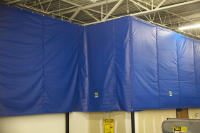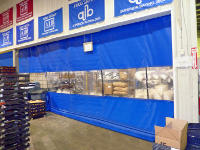The applications for industrial fabric curtain walls only grow as this relatively new product category finds different niches. First designed to partition space, they are now used for various reasons – including temperature separation and fume/odor control. Two of the newest and fastest growing applications for industrial fabric curtain walls are lowering noise levels in production and manufacturing facilities, and controlling dust. Flexible curtain walls can offer excellent protection from noise and dust in many situations, leading to safer and more pleasant industrial working environments.
Limiting Noise Hazards
The effects of machine or process noise in a commercial/industrial facility can range from an annoyance to a serious long-term safety issue for employees. In fact, OSHA estimates that more than 30 million workers are exposed to hazardous noise levels in the U.S. every year.

Assembly and machine tool operation, process equipment (such as pumps, compressors, and blowers), material handling equipment (like conveyors and fork trucks), and power hand tools (saws, grinders, and drills) are just a few common causes of industrial facility noise. The effects of human exposure to noise levels over 90 dB are cumulative; long-term exposure can result in permanent hearing loss. This makes the reduction of noise levels extremely important for employee well being.
OSHA requires employers to limit employee noise exposure to 90 dB or less on an 8-hour time weighted average basis. Employers who are found to be above the 90 dB limit in an industrial environment are required to take action to reduce employee exposure to levels below this limit.
Standard Noise Control Methods
There are multiple ways to address noise control issues in an industrial environment. These include redesign or replacement of the problematic equipment with newer, quieter models. Unfortunately, this approach isn’t always feasible, due to the cost or availability of quieter equipment. Noisy machines can sometimes be modified to reduce or eliminate noise-producing vibration – often by the addition of isolation pads or vibration dampeners. Machines may also be encased in sound-absorbing enclosures or materials.
If these approaches don’t offer the desired results, or prove impractical, noise-reduction barriers can be placed between offending equipment and the affected employees. These classically consist of rigid, insulated walls or partitions strategically placed to block the path of transmitted sound waves, absorb them, and scatter them, reducing the decibel level that actually reaches the affected employees.
The final line of defense against excessive noise involves personal hearing protection equipment, such as earplugs or passive/noise canceling earmuffs. While effective, these have the obvious shortcoming of only being useful while actually worn and fitted properly. Additionally, in a facility where hearing protection is required, regular hearing testing of affected employees is mandated by OSHA.
Sound-Dampening Fabric Curtain Walls Provide Alternative
Flexible acoustic curtain walls offer a relatively new approach to providing employee safety and comfort when it comes to noise levels in a commercial or industrial facility. These insulated fabric curtains can be very effectively used for noise source insulation, as well as for noise path insulation. Noisy machines can be wrapped in flexible sound curtains, like a blanket. They can also be attached to a close quarters support frame around the equipment. Larger sound enclosures can be formed using these modular curtains, including complete rooms or separating walls.
In addition to their excellent noise reduction performance – with sound transmission coefficients ranging from 15 to 30+ dB – flexible curtain walls as noise barriers offer additional advantages over rigid wall solutions.
Curtain walls can be configured to fit virtually any interior space and don’t require nearly the time required to build permanent walls. Sound-insulating industrial curtain walls will normally consist of two layers of a woven, coated fabric surrounding one or more layers of various insulating materials. These materials might include fiber batting (polymer or glass), which reduces sound at mid- to higher-range frequencies; open cell foam, which offers noise reduction over a range of frequencies; or densified “loaded” vinyl or other flexible polymer sheet material, which reduces lower frequency noise. Each of these components plays its own important role in reducing sound levels impinging on the curtain surface.

Dust Can Also Be an Issue
Dust or particulate suspended in air can be a nuisance, as well as a quality issue. Most importantly, however, it is a safety issue.
From a safety standpoint, there are many circumstances where high enough concentration of airborne dust-sized particulate in a closed space can become explosive or flammable. Often this can occur with seemingly innocuous products, as routinely happens in grain elevators. When grain dust becomes too highly concentrated in an air space, a spark can ignite and set off an explosive chain reaction. Additionally, airborne dust can be a health hazard to employees. These hazards can range from a skin, eye, or bronchial irritation to more serious issues for people with asthma. Most serious can be the potential for particulates to cause lung diseases like cancer (that’s why extremely thorough dust control is a critical component in asbestos remediation).
Standard Dust Control Methods
Several methods are used to keep particulate from one space from contaminating another. These include:
Local exhaust – a high velocity airflow stream captures particles at the point they are generated and carries them away. Exhaust with filtration – a high velocity airflow stream captures particles and recirculates them through a filter medium, where they are removed. Area exhaust – a high volume exhaust fan draws air from the full room volume to an outside vent or recirculates through a filtration/separation device. Barrier separation – this is simply a wall or partition between the affected areas.
Dust Issue Solution
For dust protection, each of the separation methods outlined above relies on moving a volume of air containing the dust particles. This would be accomplished through the use of exhaust fans through ducts. A local exhaust setup would incorporate some type of hood designed to collect the air and particulate being moved and funnel it into the exhaust ductwork. Area exhaust would include multiple draw points through louvered openings in the ceiling or wall. Either of these methods could, and most likely would, include some type of filtration or particle separator in line, to remove particulate from the air stream. This is necessary prior to either recirculation of the air back into the space, or discharge of the air into the atmosphere.
Curtain walls can significantly improve the effectiveness of these systems, as well as offer the opportunity for cost savings, both in the initial cost of the equipment as well as in direct operating cost.
Any time a space is to be exhausted, the smaller the space can be made, the smaller the exhaust equipment can be specified. Partitioning around a dust source with a curtain wall takes full advantage of this relationship. By reducing the volume of the space to be exhausted, smaller fan(s) can be used, with less total air movement being required. Lower air velocity through filter media increases the effective particle separation of the device. Additionally, lower air flow through the filter reduces the frequency required for changeout or cleaning.
Curtain Walls Are Convenient
Regardless of the application, industrial fabric curtain walls are both flexible and durable. They can withstand contact from machinery or product, and simply “bend without breaking,” in contrast to a hard permanent wall. Given their modular design, they are also relatively easy to reconfigure, if a space needs to be enlarged or reduced, or the shape of the space footprint needs to change. Curtain walls are easily installed, can be simply trimmed around conduit, piping, ductwork, etc., and can be anchored to the floor to withstand pressure differential across them. Depending on the application, a curtain wall can be suspended from the room ceiling, or they can be supplied with a standalone framework to hang from. They are available as stationary as well as sliding walls (suspended from roller track), and can be fitted with strip curtains, personnel doors, or high-speed industrial doors for a full range of access to the space.




